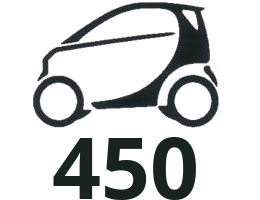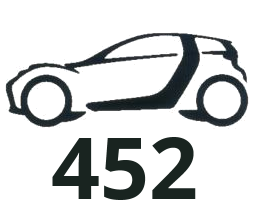Mod Description
The smart turbos differ throughout the range, some can be exchanged for others, some can't.Mod Details
PremiumNo Difficulty



 Mod ID561
CreditEvilution
For
Mod ID561
CreditEvilution
For
 Linkhttps://evilution.co.uk/mod/turbo-types-and-differences.htm Copy to Clipboard
Linkhttps://evilution.co.uk/mod/turbo-types-and-differences.htm Copy to Clipboard| 600cc | 700cc | Roadster | Diesel Turbo |
What Turbo Is It?
The turbo on the petrol 600cc/700cc fortwo and 700cc Roadster is a Garrett GT12.
The turbo on the diesel fortwo (450) is a Borg Warner unit.
The turbo on the 451 petrol is a Mitsubishi TD025.
Mk1 To Mk6 600cc Standard Turbo
This turbo is visually different to the other 2 types and can be identified by the lack of secondary air injection route below the manifold. Due to the different bolt spacing this is not a straight swap to a 700 engine.

The exhaust outlet on this turbo is 33mm ID and the stud PCD is 66mm

Inlet 25mm inside bore, 32mm outside diameter.
Outlet 21mm inside bore, 27mm outside diameter.

Manifold Cracks
It is a common fault on the old 600 turbo for cracks to appear in the manifold. This leads to loss of pressure and escaping waste gas, if this occurs the lambda sensors get confused by the readings and the engine will pulse under normal driving. The cracks aren’t very easy to spot but some can be very obvious as seen below.

There is nothing that can be done to fix the cracks, people have tried welding them closed but the inherent bad design will eventually cause more. Smart did release an updated version of the cast manifold which resists cracking to a greater extent.
Mk7~ & 61bhp Roadster 700cc Turbo
The 700cc turbo is identical to the previous 600cc turbo with the exception of the manifold, which was altered to reduce the likelihood of cracking, as described above and to add the secondary air injection route.

The inside diameter of the exhaust outlet is 33mm, the manifold stud PCD is 66mm.

The pictures show how the roadster and 700cc turbos are externally identical.

The main visual difference between the 700cc For2 and Roadster turbo can be seen by looking at the air inlet, as you can see it is straight cut on the inside whereas the Roadster turbo is chamfered on the inside edge.

The above picture shows the air inlet (ID = 25mm, OD = 32mm)
and air outlet (ID = 21mm, OD = 27mm).
The oily residue visible in the pipes is condensed burnt oil vapour which entered the turbo along with the air from the airbox through the TIK pipe. This air/vapour mixture passes through the turbo and the intercooler into the engine where it is burnt by the combustion. The oily deposits occur because the oil vapour cools after leaving the engine.
Roadster And Roadster Coupe Standard Turbo
The differences between the 700cc Fortwo and the Roadster turbo are mainly internal so telling the difference between the two can be a problem.
There are 2 easy ways to differentiate:
#1 – Either take the number stamped near the inlet to smart and get them to check it or measure the size of the exhaust outlet.
#2 – The inner diameter of the outlet (shown below) should be about 40.5mm and the PCD of the exhaust studs is about 70mm.

The picture below shows the entire underside of the turbo.
The brown cast iron section is the manifold, turbine housing, wastegate housing and exhaust outlet.
The silver section is the compressor housing.
The rust coloured section between them is the oil chamber.
The black plastic item is the wastegate actuator.
It is also worth noting the wavy cut out in the manifold header, this is the secondary air injection route. When the engine is cold the secondary air injection pump pushes cold air into the exhaust. This mixes with the fuel rich emissions to burn and heat up the catalytic convertor.

The picture below shows the top side of the turbo including the wastegate arm. Depending on the pressure in the engine, the wastegate actuator opens and closes to adjust the boost. People adjust this arm to increase boost but it’s not the best method to achieve it.

Below shows the data plate found on all smart turbos. The opening directly below it is where the air enters the turbo from the TIK pipe. The air is forced from the outlet shown in the bottom left, this joins to the intercooler and then the engine.

Inlet 27mm inside bore, 32mm outside diameter.
Outlet 21mm inside bore, 27mm outside diameter.
Diesel Turbo
Many thanks to Brian from Canadian Supercharger for these pictures and sizes.
You can see straight away that this is totally different to the other types although the manifold layout looks the same as the 600cc turbo.

The diesel turbo is far more simple when it comes to pipework to and from the wastegate actuator. Just having a single pipe instead of 6 on the 700cc actuator.

The exhaust outlet also has a different shape and angle meaning a dedicated exhaust system is needed, the petrol smart exhaust just won’t fit.

Dimensions Comparison
| 600cc | 700cc | Diesel | Roadster | ||
| Exhaust outlet | |||||
| Inside diameter (mm) | 33 | 33 | 33 | 40.5 | |
| Manifold stud | |||||
| PCD (mm) | 66 | 66 | 66 | 72 | |
| Air inlet | |||||
| Inside diameter (mm) | 25 | 25 | 31 | 27 | |
| Outside diameter (mm) | 32 | 32 | 34 | 32 | |
| Air outlet | |||||
| Inside diameter (mm) | 21 | 21 | 21 | 21 | |
| Outside diameter (mm) | 27 | 27 | 28 | 27 | |
Simplified Manifold Layout
600cc Turbo Manifold

700cc Turbo Manifold

At present I do not have access to a diesel turbo but if I manage to find one I will put the info on here.
More Info
600cc – GT123 and GT1238S
700cc – GT1238S
Roadster – GT1238S
Roadster Brabus – GT12SM
999cc – TD025M-08T-3.3 (49173-02010)
GT1238 vs GT12SM
From what I can see, the turbo cartridge is the same. The only difference is the wastegate actuator on the Brabus has a slightly stronger internal spring.


